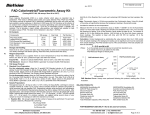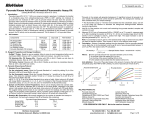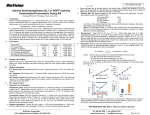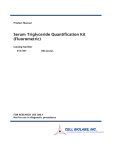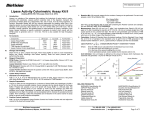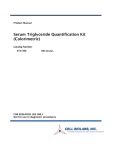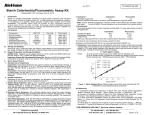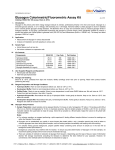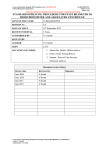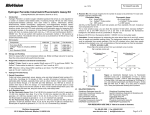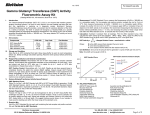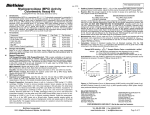Download Data Sheet - BioVision
Transcript
BioVision For research use only rev. 02/13 Lipase Activity Colorimetric Assay Kit (Catalog #K722-100; 100 assays; Store kit at -20oC) II. Introduction: Lipases perform essential roles in the digestion, transport and processing of dietary lipids (e.g. fats and oils) in living organisms. In humans, pancreatic lipase is the key enzyme responsible for breaking down fats in the digestive system by converting triglyceride to monoglyceride and free fatty acid. Pancreatic lipase monitoring is also used to help diagnose Crohn's disease, cystic fibrosis and celiac disease. Damage to the pancreas can exhibit a 5 - 10 fold increase of serum lipase levels within 24 to 48 hours. In BioVision’s Lipase Assay Kit, lipase hydrolyzes a triglyceride substrate to form glycerol which is quantified enzymatically by via monitoring a linked change in the OxiRed probe absorbance (λ = 570nm). This assay is rapid, simple, sensitive, and reliable, as well as, suitable for high throughput activity screening of lipase. This kit detects lipase activity as low as 0.02 mU per well. Kit Contents: Components Lipase Assay Buffer OxiRed™ (in DMSO) Enzyme Mix (lyophilized) Lipase Substrate Glycerol Standard (100 mM) Lipase Positive Control (lyophilized) 100 assays 25 ml 0.2 ml 1 vial 0.4 ml 0.2 ml 1 vial Cap Code WM Red Green Blue Yellow Purple Part Number K722-100-1 K722-100-2A K722-100-4 K722-100-5 K722-100-6 K722-100-7 III. BioVision Incorporated 155 S. Milpitas Boulevard, Milpitas, CA 95035 USA Lipase Activity = (B x Dilution factor) = nmol/min/ml = mU/ml (T2 - T1) x V Where: B is the Glycerol amount from the Standard Curve (in nmol). T1 is the time of the first reading (A1) (in min). T2 is the time of the second reading (A2) (in min). V is the pretreated sample volume added into the reaction well (in ml). Unit Definition: One unit is defined as the amount of lipase that hydrolyzes triglyceride to yield 1.0µmol of glycerol per minute at 37°C. Glycerol standard curve 2 OD 570 nm Storage and Handling: Store the kit at -20°C, protect from light. Allow Assay Buffer to warm to room temperature before use. Briefly centrifuge vials before opening. Read the entire protocol before performing the assay. IV. Reagent preparation: Probe: Ready to use as supplied. Warm to room temperature to melt frozen DMSO before use. Store at -20°C, protect from light and moisture. Enzyme Mix: Dissolve in 220 µl Assay Buffer. Partition into aliquots in vials and store at -20°C. Use within two months. Lipase Substrate: Freezing for storage may cause the substrate to separate from the aqueous phase. To redissolve the substrate, keep the cap tightly closed, thaw then place in a hot water bath (80 - 100°C) for 1 minute until the substrate looks cloudy, vortex for 30 seconds. The substrate should be clear. Repeat heat and vortex one more time. The substrate is now completely in solution, and ready for use. Lipase positive control: Dissolve the positive control in 100 µl Assay Buffer. Add 5 µl and adjust the volume to 50 µl/well with Assay Buffer as positive control. Store at -20°C V. Lipase Assay Protocol: 1. Standard Curve Preparation: Add 10 µl of the glycerol standard to 990 µl of Assay Buffer to generate 1 mM glycerol, mix well. Add 0, 2, 4, 6, 8, 10 µl into a series of wells. Adjust volume to 50 µl/well with Assay Buffer to generate 0, 2, 4, 6, 8, 10 nmol/well of glycerol Standard. 2. Sample Preparations: Tissues (40 mg) or cells (2 x 106) can be homogenized in 4 volumes of Assay Buffer. Centrifuge to remove insoluble material at 13,000 x g, 10 min. Serum samples can be directly diluted in the Assay Buffer. Prepare test samples of up to 50 µl/well with Assay Buffer in a 96-well plate. We suggest testing several doses of your sample to make sure readings are within the standard curve. Glycerol in the sample will interfere with the result. It is corrected for by using a (substrate deficient) control for the sample. Note: Some Lipases require calcium. If your lipase requires calcium avoid EGTA in sample preparation and add calcium (1 - 5 mM) to the Lipase assay buffer before use. Glycerol in the sample will interfere with the result. It is corrected for by using a (substrate deficient) control for the sample. 3. Reaction Mix: Mix enough reagent for the number of assays to be performed. For each well, prepare a total 100 µl Reaction Mix. Sample Control Assay Buffer 93 µl 96 µl OxiRed Probe 2 µl 2 µl Enzyme Mix 2 µl 2 µl Lipase substrate 3 µl ----Add 100 µl of the Sample Reaction Mix to each well containing the Glycerol Standards, Lipase positive controls, and test samples. Add 100 µl Control Reaction Mix to each well containing the sample controls. Mix well. 4. Incubate: Measure OD 570 nm at T1 to read A1, measure OD 570 nm again at T2 after incubating the reaction at 37°C for 60 - 90 min (or incubate longer time if the Lipase activity is low) to read A2, protect from light. 5. Calculation: The OD generated by oxidation of glycerol is ∆A570 nm = A2 – A1.Subtracting the OD 570 nm value of control from the sample to avoid glycerol in the sample. Plot Glycerol Standard Curve, Apply the ∆A570 nm to the glycerol standard curve to get B nmol of glycerol (glycerol amount generated between T1 and T2 in the reaction wells).Glycerol generated in the test samples can then be calculated: Sample timeline 1.5 1.6 1.2 y = 0.1746x + 0.0103 0.8 OD 570nm I. sample 01 1 sample 02 0.5 0.4 Background 0 0 0 2 4 6 8 Glycerol (nmol/per well) RELATED PRODUCTS: NAD/NADH Quantification Kit ADP/ATP Ratio Assay Kit Glucose Assay Kit Ethanol Assay Kit Pyruvate Assay Kit Creatine Assay Kit Triglyceride Assay Kit 10 0 10 20 Time (min) NADP/NADPH Quantitation Kit Ascorbic Acid Quantification Kit Fatty Acid Assay Kit Uric Acid Assay Kit Lactate Assay Kit/ II Creatinine Assay Kit Free Glycerol Assay Kit FOR RESEARCH USE ONLY! Not to be used on humans. Tel: 408-493-1800 | Fax: 408-493-1801 www.biovision.com | [email protected] Page 1 of 2 30 BioVision rev. 02/13 For research use only GENERAL TROUBLESHOOTING GUIDE: Problems Cause Solution Assay not working • Use of ice-cold assay buffer • Assay buffer must be at room temperature • Omission of a step in the protocol • Refer and follow the data sheet precisely • Plate read at incorrect wavelength • Check the wavelength in the data sheet and the filter settings of the instrument • Use of a different 96-well plate • Fluorescence: Black plates (clear bottoms) ; Luminescence: White plates ; Colorimeters: Clear plates • Use of an incompatible sample type • Refer data sheet for details about incompatible samples • Samples prepared in a different buffer • Use the assay buffer provided in the kit or refer data sheet for instructions • Cell/ tissue samples were not completely homogenized • Use Dounce homogenizer (increase the number of strokes); observe for lysis under microscope • Samples used after multiple free-thaw cycles • Aliquot and freeze samples if needed to use multiple times • Presence of interfering substance in the sample • Troubleshoot if needed • Use of old or inappropriately stored samples • Use fresh samples or store at correct temperatures until use • Improperly thawed components • Thaw all components completely and mix gently before use • Use of expired kit or improperly stored reagents • Always check the expiry date and store the components appropriately • Allowing the reagents to sit for extended times on ice • Always thaw and prepare fresh reaction mix before use • Incorrect incubation times or temperatures • Refer datasheet & verify correct incubation times and temperatures • Incorrect volumes used • Use calibrated pipettes and aliquot correctly • Use of partially thawed components • Thaw and resuspend all components before preparing the reaction mix • Pipetting errors in the standard • Avoid pipetting small volumes • Pipetting errors in the reaction mix • Prepare a master reaction mix whenever possible Samples with erratic readings Lower/ Higher readings in Samples and Standards Readings do not follow a linear pattern for Standard curve Unanticipated results • Air bubbles formed in well • Pipette gently against the wall of the tubes • Standard stock is at an incorrect concentration • Always refer the dilutions in the data sheet • Calculation errors • Recheck calculations after referring the data sheet • Substituting reagents from older kits/ lots • Use fresh components from the same kit • Measured at incorrect wavelength • Check the equipment and the filter setting • Samples contain interfering substances • Troubleshoot if it interferes with the kit • Use of incompatible sample type • Refer data sheet to check if sample is compatible with the kit or optimization is needed • Sample readings above/below the linear range • Concentrate/ Dilute sample so as to be in the linear range Note: The most probable list of causes is under each problem section. Causes/ Solutions may overlap with other problems. BioVision Incorporated 155 S. Milpitas Boulevard, Milpitas, CA 95035 USA Tel: 408-493-1800 | Fax: 408-493-1801 www.biovision.com | [email protected] Page 2 of 2


